Gemological and Chemical Composition Characteristics of Basalt-Related Rubies from Chanthaburi-Trat, Thailand
Abstract
1. Introduction
2. Materials and Methods
3. Results
3.1. Gemological Properties
3.2. Microscopic Characteristics and Inclusion Raman Spectra
3.3. Electron Microprobe Analysis and LA-ICP-MS Analysis
4. Discussion
4.1. Classification of Ruby Deposits
4.2. Gemological Properties
4.3. Microscopic Inclusions
4.4. Trace-Element Variations
5. Conclusions
Author Contributions
Funding
Data Availability Statement
Acknowledgments
Conflicts of Interest
References
- Giuliani, G.; Groat, L.A.; Fallick, A.E.; Pignatelli, I.; Pardieu, V. Ruby Deposits: A review and geological classification. Minerals 2020, 10, 597. [Google Scholar] [CrossRef]
- Groat, L.A.; Giuliani, G.; Stone-Sundberg, J.; Renfro, N.D.; Sun, Z. A review of analytical methods used in geographic origin determination of gemstones. Gems Gemol. 2019, 55, 512–535. [Google Scholar] [CrossRef]
- Giuliani, G.; Ohnenstetter, D.; Fallick, A.E. The geology and genesis of gem corundum deposits. In Geology of Gem Deposits; Groat, L.A., Ed.; Mineralogical Association of Canada: Québec, QC, Canada, 2014; pp. 35–112. [Google Scholar]
- Keller, P.C. The Chanthaburi-Trat Gem Field, Thailand. Gems Gemol. 1982, 18, 186–196. [Google Scholar] [CrossRef]
- Gübelin, E.J.; Koivula, J.I. Photoatlas of Inclusions in Gemstones; ABC Edition: Zurich, Switzerland, 1986. [Google Scholar]
- Koivula, J.I.; Fryer, C.W. Sapphirine (not sapphire) in a ruby from Bo Rai, Thailand. J. Gemmol. 1987, 20, 370. [Google Scholar] [CrossRef]
- Sutherland, F.L.; Schwarz, D.; Jobbins, E.A.; Coenraads, R.R.; Webb, G. Distinctive gem corundum suites from discrete basalt fields: A comparative study of Barrington, Australia, and West Pailin, Cambodia, gemfields. J. Gemmol. 1998, 26, 65–85. [Google Scholar] [CrossRef]
- Sutthirat, C.; Saminpanya, S.; Droop, G.T.R.; Henderson, C.M.B.; Manning, D.A.C. Clinopyroxene-corundum assemblages from alkali basalt and alluvium, eastern Thailand: Constraints on the origin of Thai rubies. Mineral. Mag. 2001, 65, 277–295. [Google Scholar] [CrossRef]
- Saminpanya, S.; Sutherland, F.L. Different origins of Thai area sapphire and ruby, derived from mineral inclusions and co-existing minerals. Eur. J. Mineral. 2011, 23, 683–694. [Google Scholar] [CrossRef]
- Sangsawong, S.; Vertriest, W.; Saeseaw, S.; Pardieu, V.; Muyal, J.; Khowpong, C.; Atikarnsakul, U.; Weeramonkhonlert, V. A study of rubies from Cambodia and Thailand. GIA Research News. 2017. Available online: https://www.gia.edu/gia-news-research/study-rubies-cambodia-thailand (accessed on 28 March 2023).
- Palke, A.C.; Wong, J.; Verdel, C.; Ávila, J.N. A common origin for Thai/Cambodian rubies and blue and violet sapphires from Yogo Gulch, Montana, USA? Am. Mineral. 2018, 103, 469–479. [Google Scholar] [CrossRef]
- Palke, A.C.; Saeseaw, S.; Renfro, N.D.; Sun, Z.; McClure, S.F. Geographic Origin Determination of Ruby. Gems Gemol. 2019, 55, 580–612. [Google Scholar] [CrossRef]
- Promwongan, S.; Sutthirat, C. Mineral inclusions in ruby and sapphire from the Bo Welu gem deposit in Chanthaburi, Thailand. Gems Gemol. 2019, 55, 354–369. [Google Scholar]
- Promwongan, S.; Sutthirat, C. An update on mineral inclusions and their composition in ruby from the Bo Rai gem field in Trat Province, eastern Thailand. J. Gemmol. 2019, 36, 634–645. [Google Scholar] [CrossRef]
- Palke, A.C. Coexisting rubies and blue sapphires from major world deposits: A brief review of their mineralogical properties. Minerals 2020, 10, 472. [Google Scholar] [CrossRef]
- Giuliani, G.; Fallick, A.E.; Garnier, V.; France-Lanord, C.; Ohnenstetter, D.; Schwarz, D. Oxygen isotope composition as a tracer for the origins of rubies and sapphires. Geology 2005, 33, 249–252. [Google Scholar] [CrossRef]
- Yui, T.F.; Wu, C.-M.; Limkatrun, P.; Sricharn, W.; Boonsoong, A. Oxygen isotope studies on placer sapphire and ruby in the Chanthaburi-Trat alkali basaltic gemfield, Thailand. Lithos 2006, 86, 197–211. [Google Scholar] [CrossRef]
- Coenraads, R.R. Surface features on natural rubies and sapphires derived from volcanic provinces. J. Gemmol. 1992, 23, 151–160. [Google Scholar] [CrossRef]
- Hughes, R.W. Ruby and Sapphire; RWH Publishing: Boulder, CO, USA, 1997. [Google Scholar]
- Hughes, R.W.; Manorotkul, W.; Hughes, E.B. Ruby and Sapphire: A Gemologist’s Guide; RWH Publishing/Lotus Publishing: Bangkok, Thailand, 2017; p. 816. [Google Scholar]
- Vertriest, W.; Palke, A.C.; Renfro, N.D. Field gemology: Building a research collection and understanding the development of gem deposits. Gems Gemol. 2019, 55, 490–511. [Google Scholar] [CrossRef]
- Bowersox, G.W.; Foord, E.E.; Laurs, B.M.; Shigley, J.E.; Smith, C.P. Ruby and sapphire from Jegdalek, Afghanistan. Gems Gemol. 2000, 36, 110–126. [Google Scholar] [CrossRef]
- Pignatelli, I.; Giuliani, G.; Morlot, C.; Pham, V.L. The texture and chemical composition of trapiche ruby from Khoan Thong, Luc Yen mining district, northern Vietnam. J. Gemmol. 2019, 36, 726–745. [Google Scholar] [CrossRef]
- Schwarz, D.; Schmetzer, K. Rubies from the Vatomandry area, eastern Madagascar. J. Gemmol. 2001, 27, 409–416. [Google Scholar] [CrossRef]
- Pardieu, V. Ruby and Sapphire Rush near Didy, Madagascar. April–June 2012. Available online: https://www.gia.edu/doc/Ruby-and-Sapphire-Rush-Near-Didy-Madagascar.pdf (accessed on 25 July 2023).
- Kongsomart, B.; Vertriest, W.; Weeramonkhonlert, V. Preliminary observations on facet-grade ruby from Longido, Tanazania. Gems Gemol. 2017, 53, 472–473. [Google Scholar]
- Schwarz, D.; Pardieu, V.; Saul, J.M.; Schmetzer, K.; Laurs, B.M.; Giuliani, G.; Klemm, L.; Malsy, A.K.; Hauzenberger, C.; Du Toit, G.; et al. Ruby and sapphires from Winza (Central Tanzania). Gems Gemol. 2008, 44, 322–347. [Google Scholar] [CrossRef]
- Yakymchuk, C.; Hinsberg, V.V.; Kirkland, C.L.; Szilas, K.; Kinney, C.; Kendrick, J.; Hollis, J.A. Corundum (ruby) growth during the final assembly of the Archean North Atlantic Craton, southern West Greenland. Ore Geol. Rev. 2021, 138, 104417. [Google Scholar] [CrossRef]
- Khaleal, F.M.; Saleh, G.M.; Lasheen, E.S.R.; Alzahrani, A.M.; Kamh, S.Z. Exploration and Petrogenesis of Corundum-Bearing Pegmatites: A Case Study in Migif-Hafafit Area, Egypt. Front. Earth Sci. 2022, 10, 869828. [Google Scholar] [CrossRef]
- Sutherland, F.L.; Hoskin, P.W.O.; Fanning, C.M.; Coenraads, R.R. Models of corundum origin from alkali basaltic terrains: A reappraisal. Contrib. Mineral. Petrol. 1998, 133, 356–372. [Google Scholar] [CrossRef]
- Simonet, C.; Fritsch, E.; Lasnier, B.A. classification of gem corundum deposits aimed towards gem exploration. Ore Geol. Rev. 2008, 34, 127–133. [Google Scholar] [CrossRef]
- Giuliani, G.; Groat, L.A. Geology of corundum and emerald gem deposits: A review. Gems Gemol. 2019, 55, 464–489. [Google Scholar] [CrossRef]
- Zhang, B.L.; Schwarz, D.; Lu, T.J. Geographic Origin Determination of Colored Gemstones; The Geological Publishing House: Beijing, China, 2012; pp. 109–186. [Google Scholar]
- Garnier, V.; Giuliani, G.; Ohnenstetter, D.; Fallick, A.E.; Dubessy, J.; Banks, D.; Vinh, H.Q.; Lhomme, T.; Maluski, H.; Pêcher, A.; et al. Marble-hosted ruby deposits from Central and Southeast Asia: Towards a new genetic model. Ore Geol. Rev. 2008, 34, 169–191. [Google Scholar] [CrossRef]
- Vertriest, W.; Saeseaw, S. A decade of ruby from Mozambique: A review. Gems Gemol. 2019, 55, 162–183. [Google Scholar] [CrossRef]
- Peretti, A.; Schmetzer, K.; Bernhardt, H.J.; Mouawad, F. Rubies from Mong Hsu. Gems Gemol. 1995, 31, 2–26. [Google Scholar] [CrossRef]
- Xu, B.; Hou, Z.Q.; Griffin, W.L.; Lu, Y.; Belousova, E.; Xu, J.F.; O’Reilly, S.Y. Recycled volatiles determine fertility of porphyry deposits in collisional settings. Am. Mineral. 2021, 106, 656–661. [Google Scholar] [CrossRef]
- Xu, B.; Hou, Z.Q.; Griffin, W.L.; Zheng, Y.C.; Wang, T.; Guo, Z.; Hou, J.; Santosh, M.; O’Reilly, S.Y. Cenozoic lithospheric architecture and metallogenesis in Southeastern Tibet. Earth Sci. Rev. 2021, 214, 103472. [Google Scholar] [CrossRef]
- Xu, B.; Hou, Z.Q.; Griffin, W.L.; O’Reilly, S.Y. Apatite halogens and Sr–O and zircon Hf–O isotopes: Recycled volatiles in Jurassic porphyry ore systems in southern Tibet. Chem. Geol. 2022, 605, 120924. [Google Scholar] [CrossRef]
- Peucat, J.J.; Ruffault, P.; Fritsch, E.; Bouhnik-Le Coz, M.; Simonet, C.; Lasnier, B. Ga/Mg ratios as a new geochemical tool to differentiate magmatic from metamorphic blue sapphires. Lithos 2007, 98, 261–274. [Google Scholar] [CrossRef]
- Sutherland, F.; Zaw, K.; Meffre, S.; Yui, T.-F.; Thu, K. Advances in Trace Element “Fingerprinting” of Gem Corundum, Ruby and Sapphire, Mogok Area, Myanmar. Minerals 2014, 5, 61–79. [Google Scholar] [CrossRef]
- Zaw, K.; Sutherland, F.L.; Yui, T.F.; Meffre, S.; Thu, K. Vanadium-rich ruby and sapphire within Mogok gemfield, Myanmar: Implications for gem color and genesis. Mineral. Depos. 2015, 50, 25–39. [Google Scholar] [CrossRef]
- Perretti, A. The Making of an International Color Standard by GRS: “Pigeon’s Blood” and “Royal Blue”. Definitions, Retroperspective and Future. 2015. Available online: https://www.gemresearch.ch/pigeonsblood (accessed on 25 July 2023).
- Pardieu, V.; Sangsawong, S.; Chauviré, B.; Massi, L.; Sturman, N. Rubies from the Montepuez area (Mozambique), Bangkok, GIA Laboratory. 2013. Available online: https://www.gia.edu/doc/GIA_Ruby_Montepuez_Mozambique.pdf (accessed on 28 March 2023).
- Sutherland, F.L.; Khin, Z.; Meffre, F.; Thompson, J.; Goemann, K.; Kyaw, T.; Than, T.N.; Mhod, Z.M.; Harris, S.I. Diversity in ruby chemistry and its inclusions: Intra and inter-continental comparisonsfrom Myanmar and Eastern Australia. Minerals 2019, 9, 28. [Google Scholar] [CrossRef]
- Chulapakorn, T.; Intarasiri, S.; Bootkul, D.; Singkarat, S. Identification of deposit types of natural corundum by PIXE. Nucl. Instrum. Methods Phys. Res. B 2014, 331, 108–112. [Google Scholar] [CrossRef]
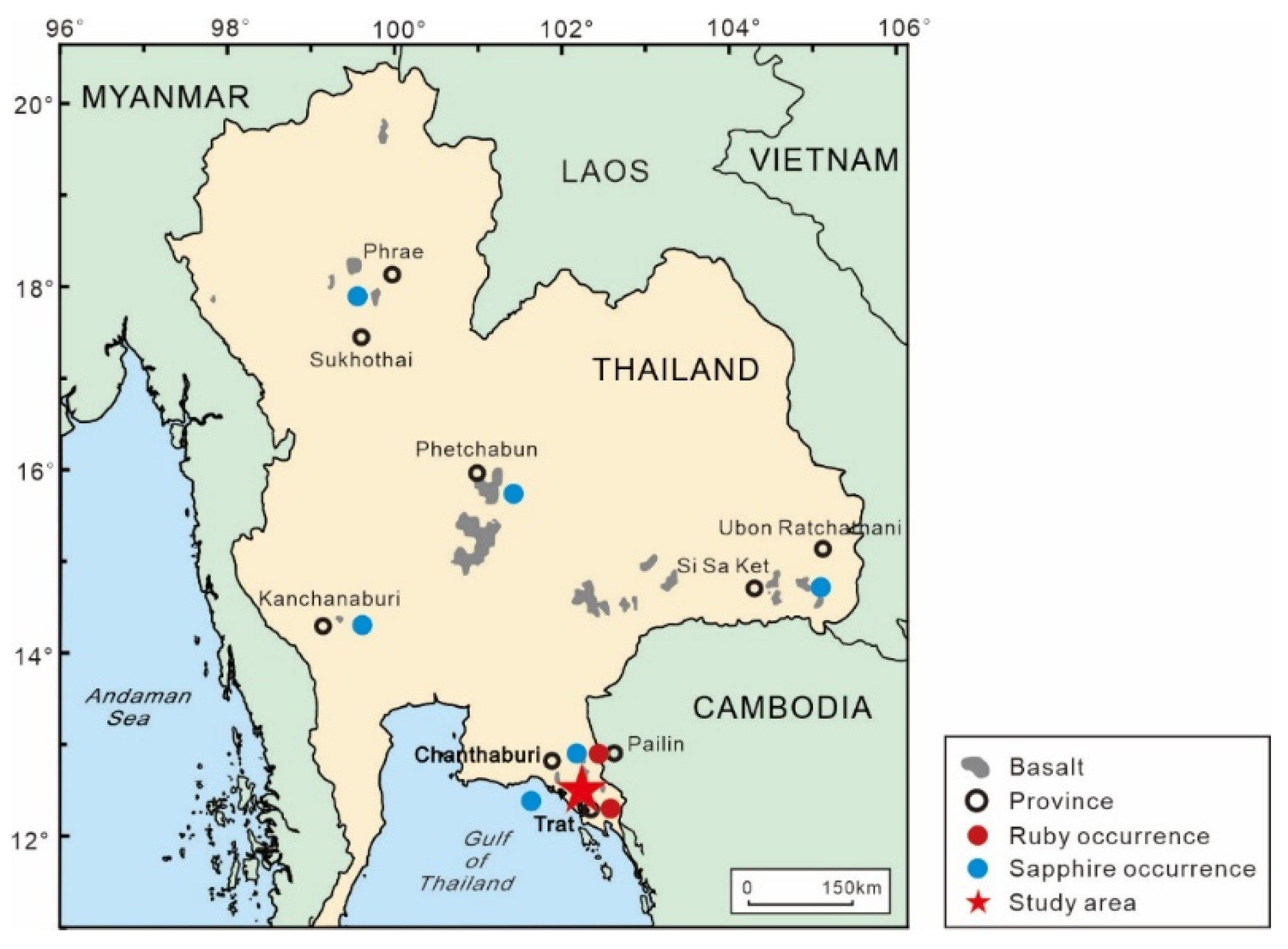
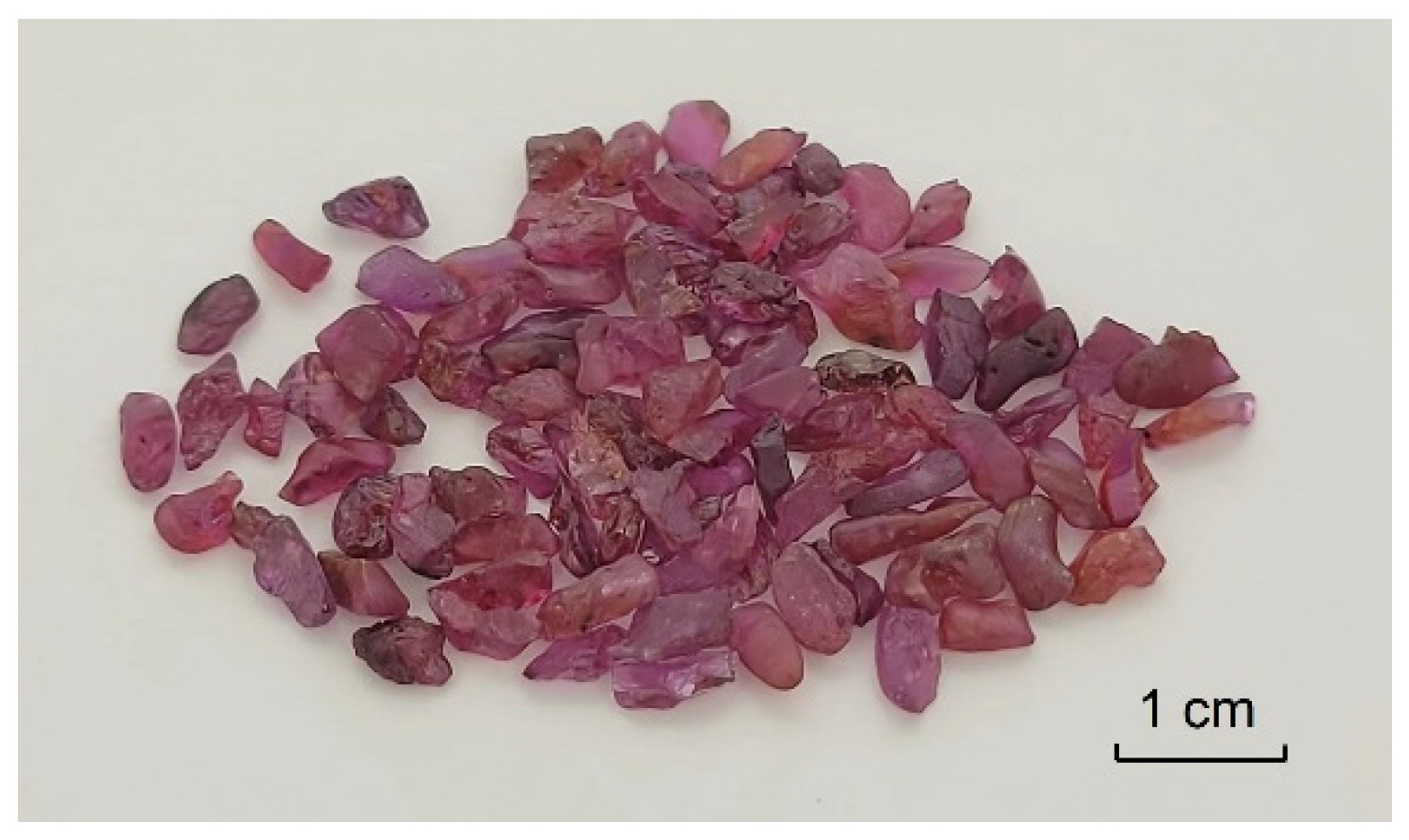

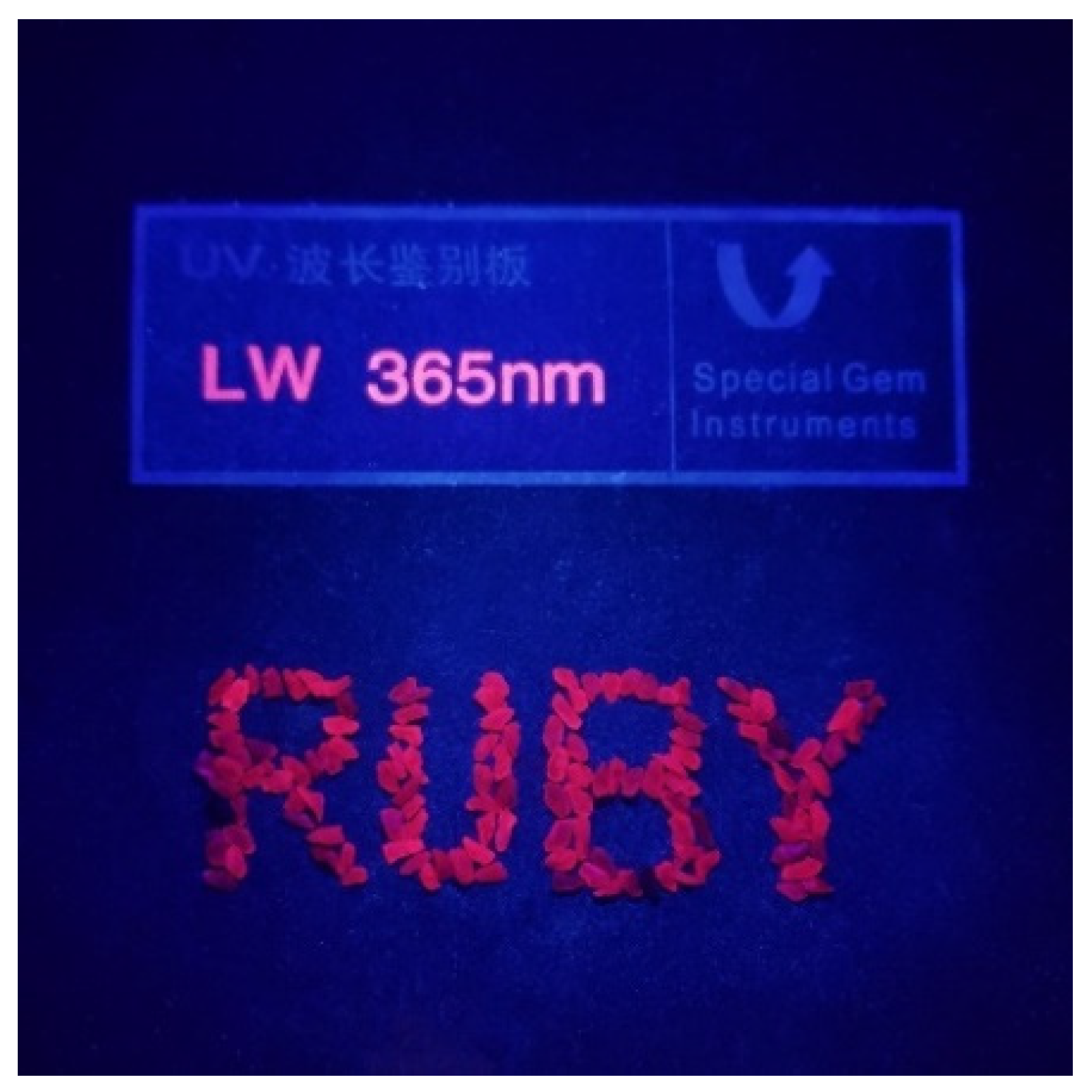

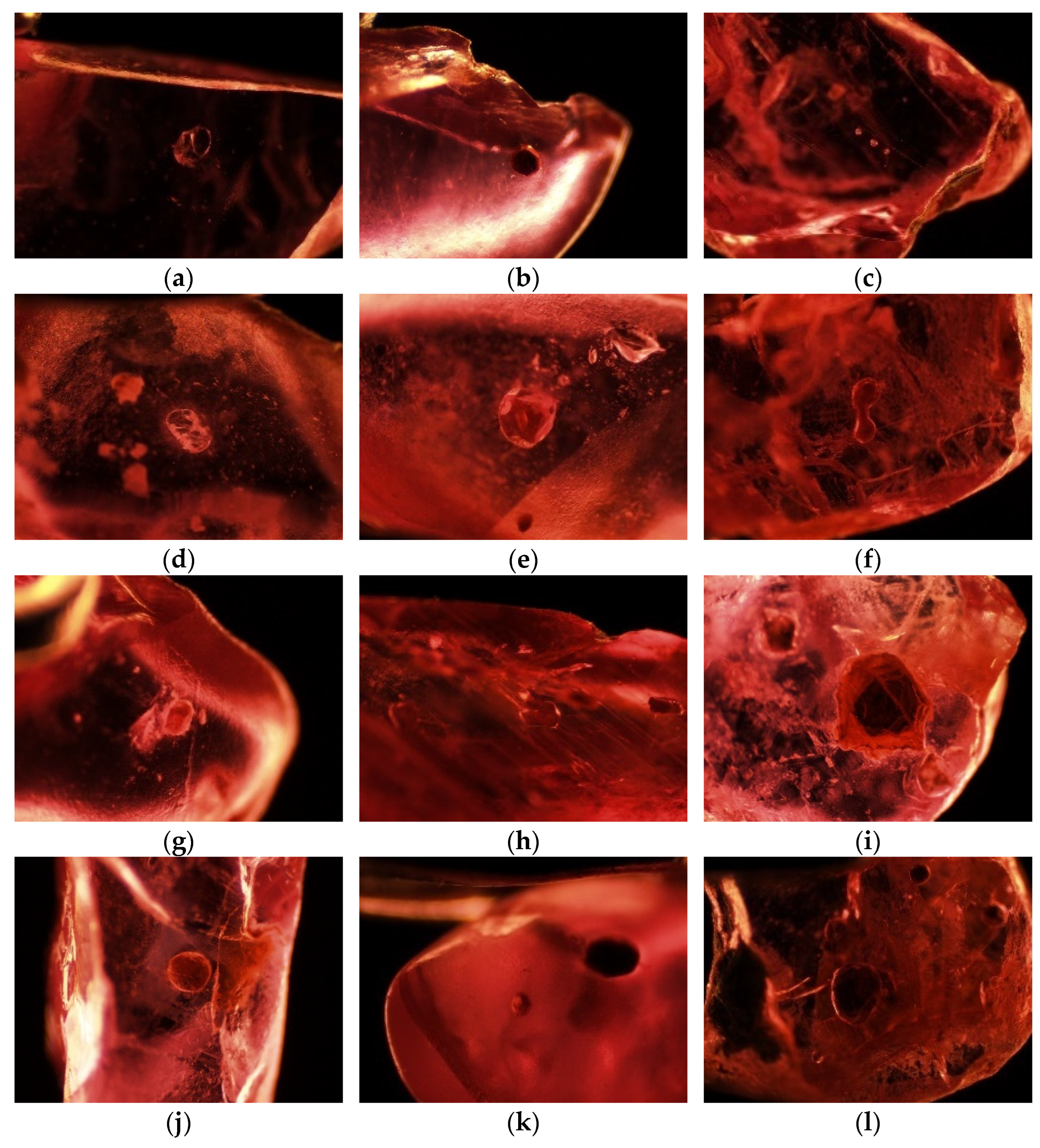
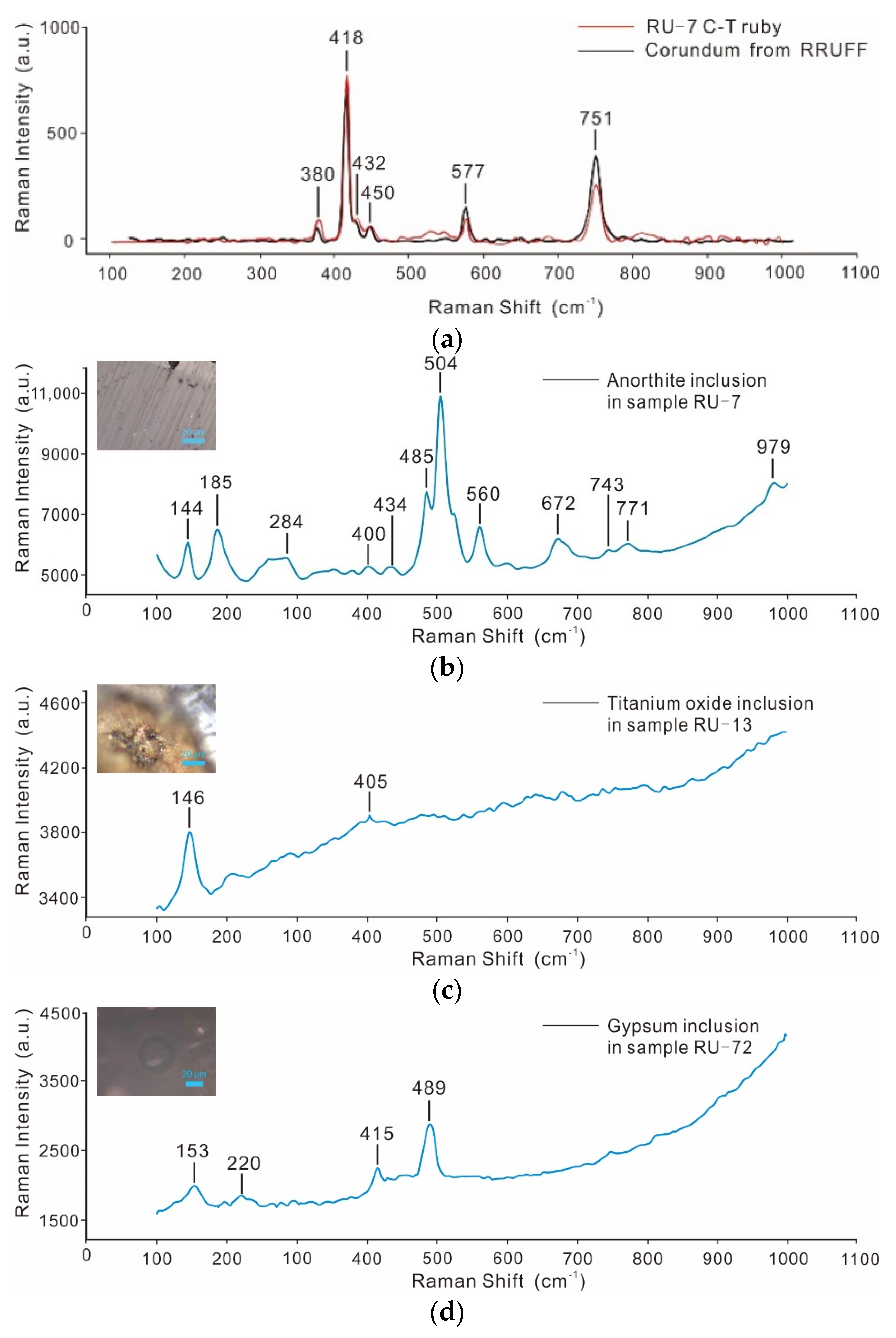

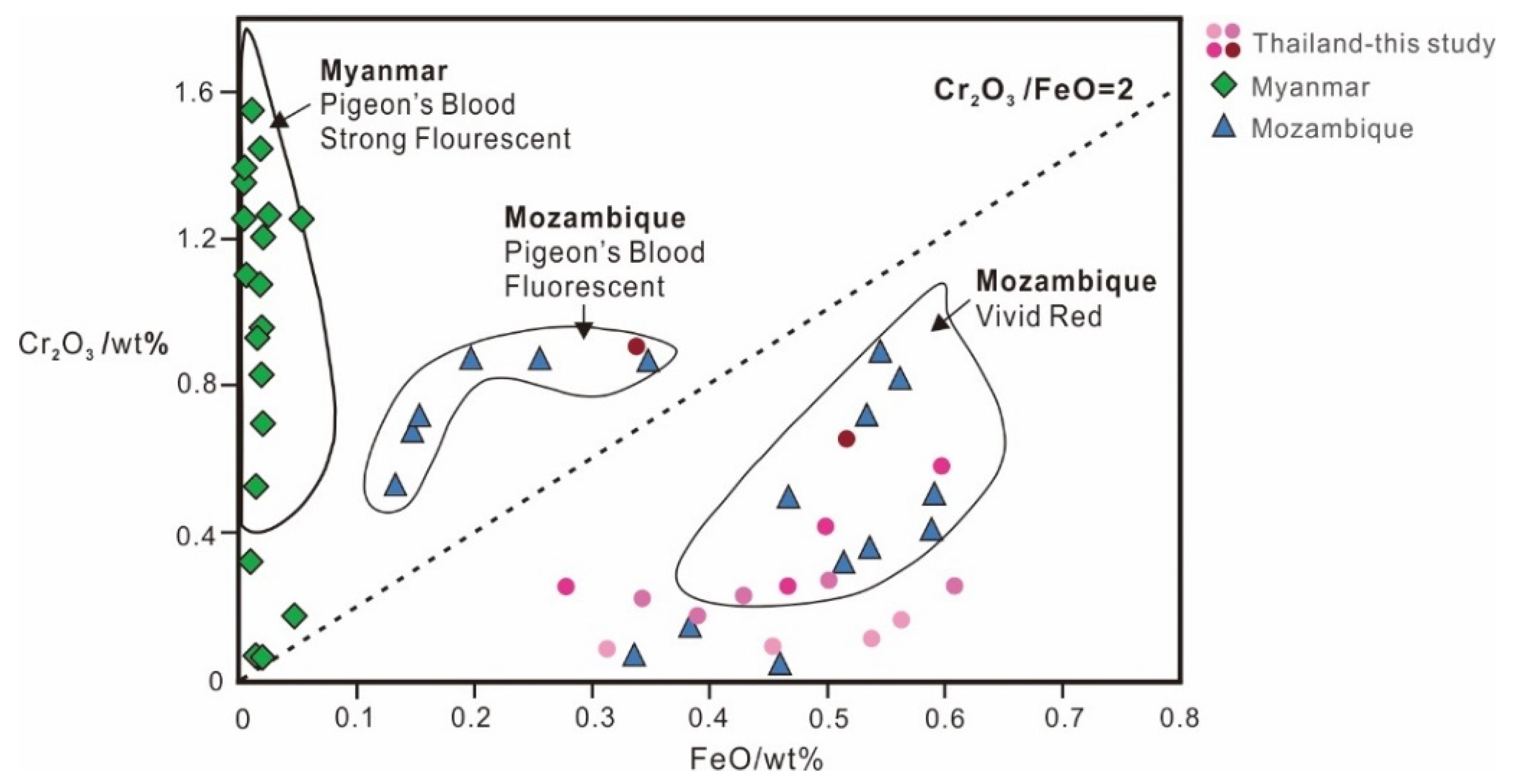

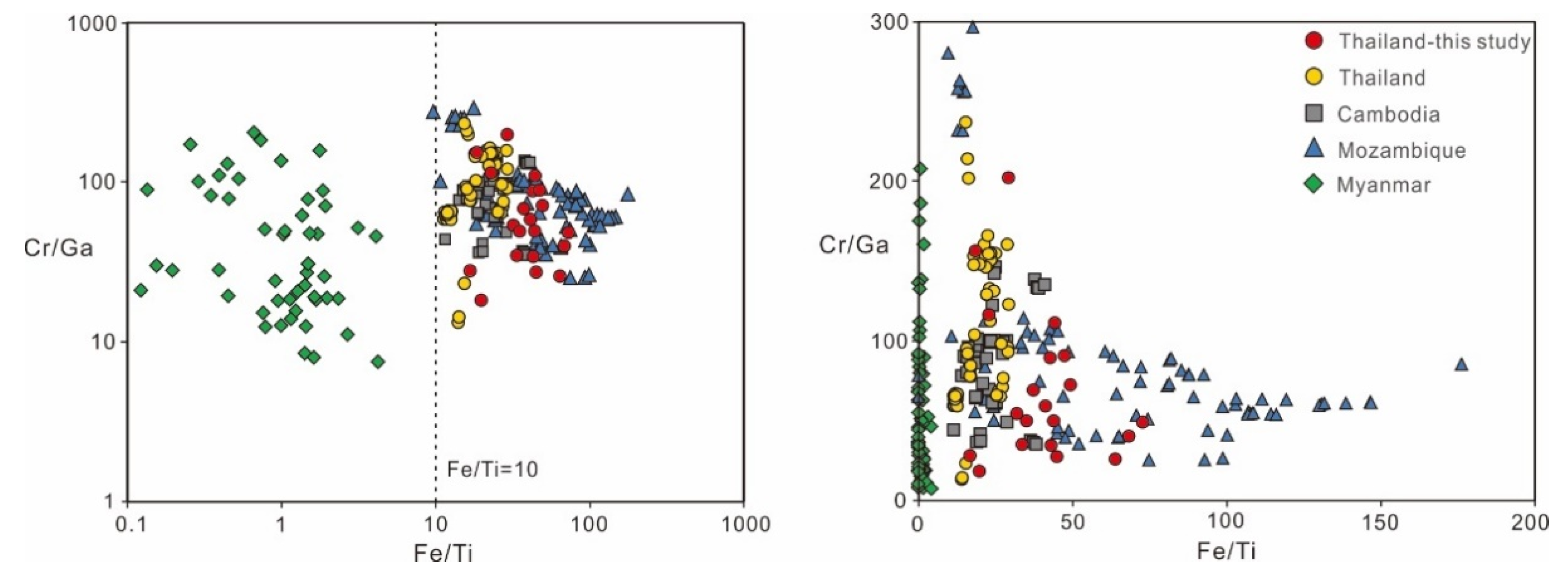
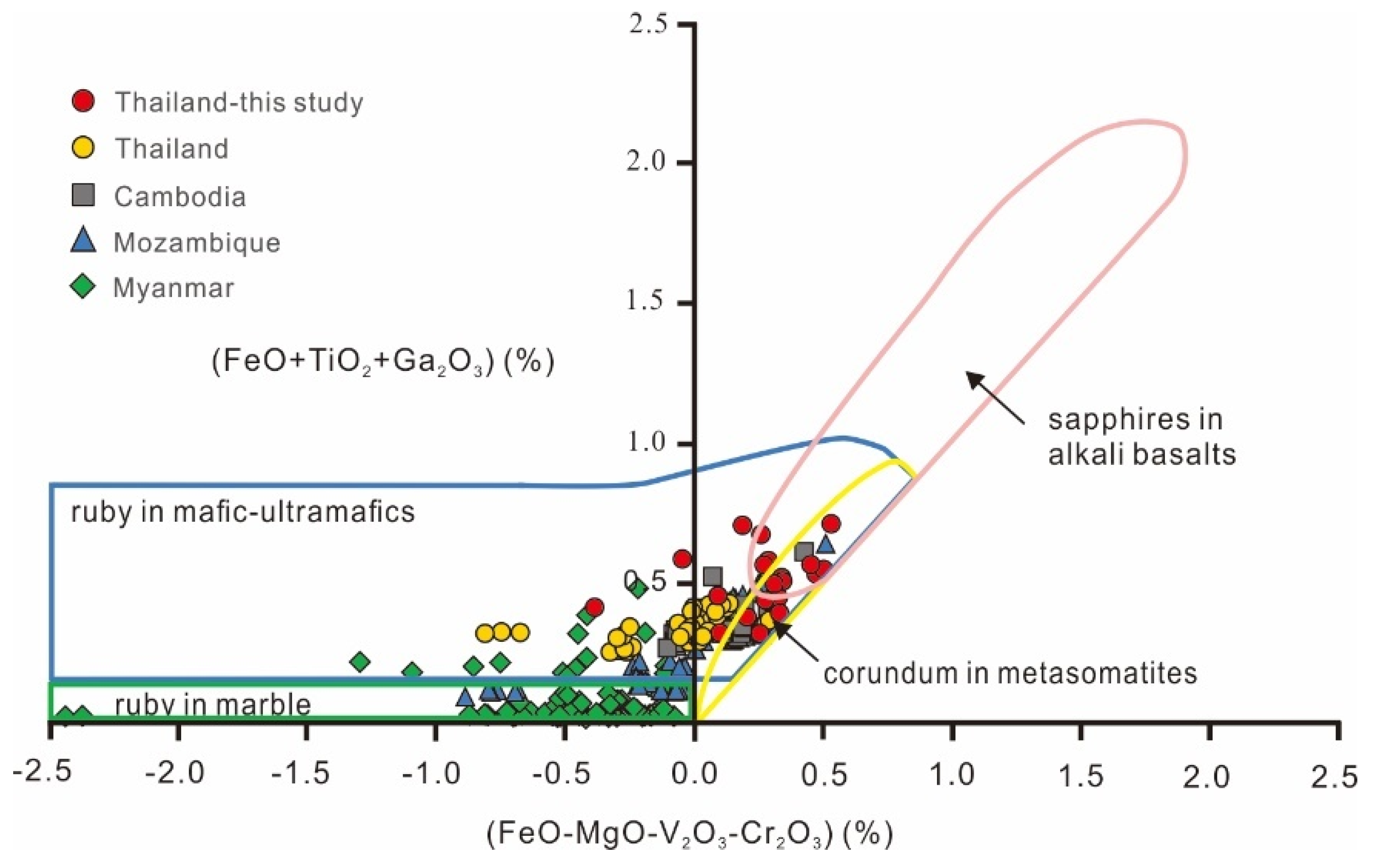
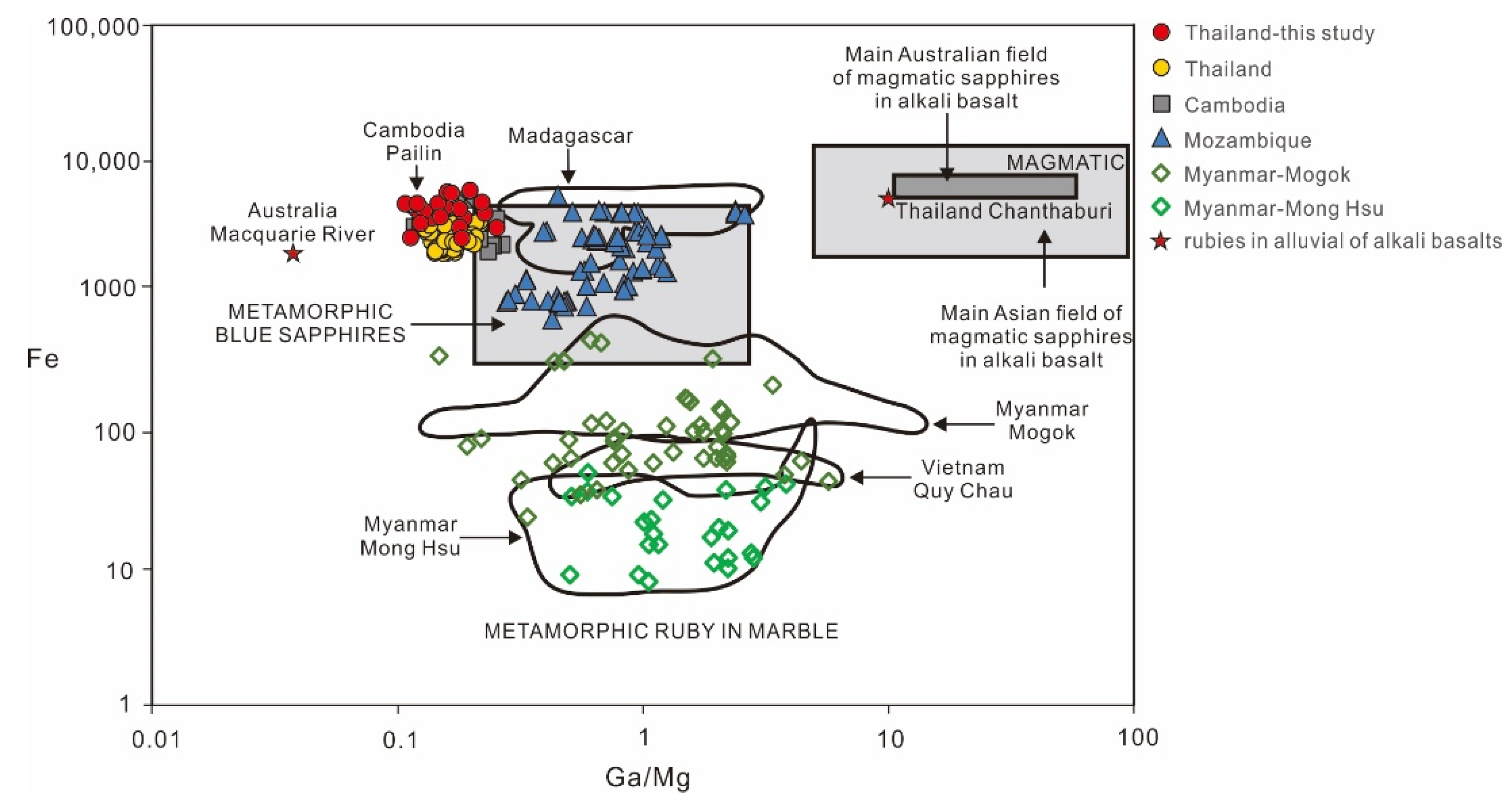
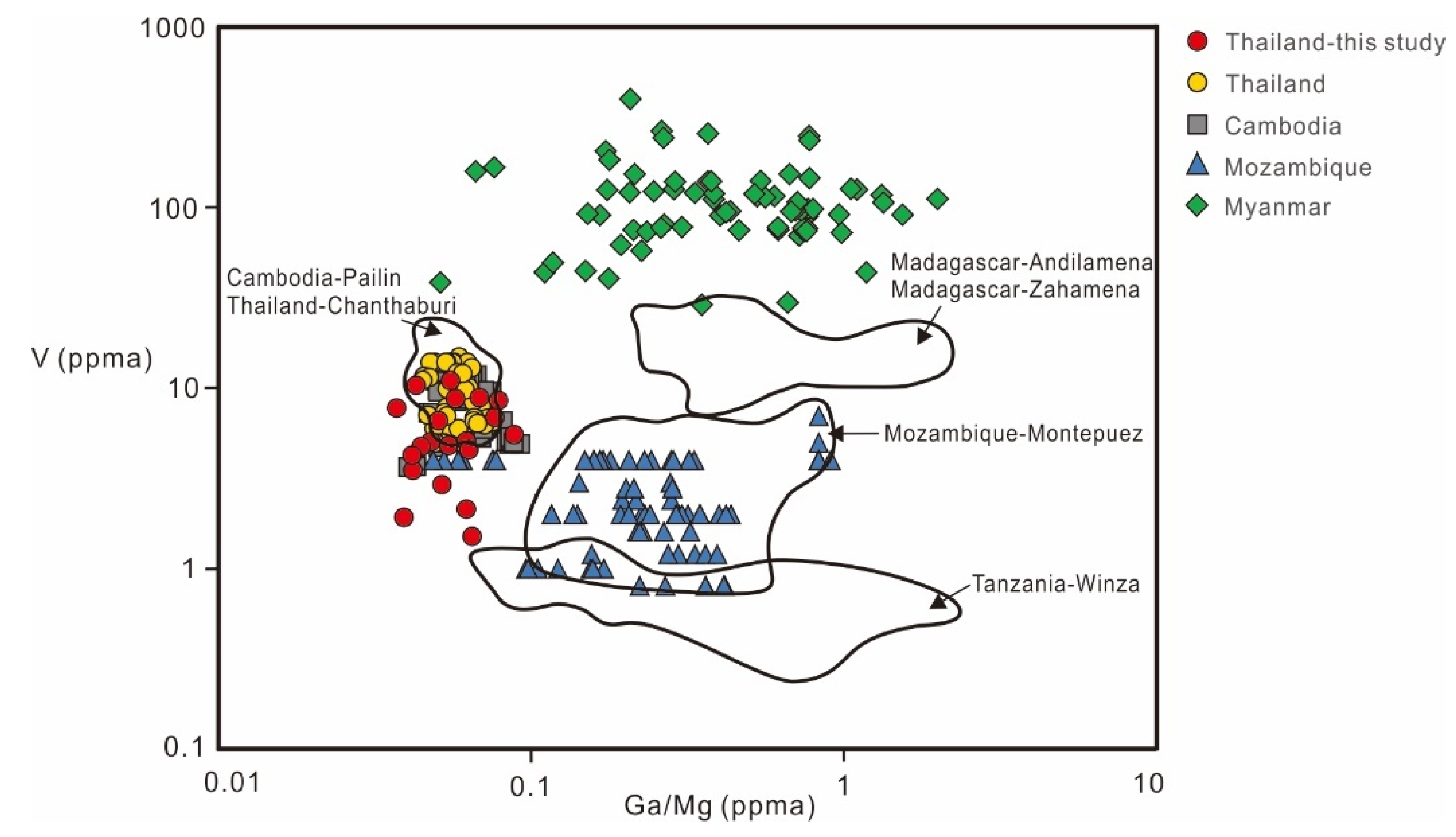
| Label | Color | Al2O3 | Cr2O3 | MgO | FeO | TiO2 | V2O3 | Ga2O3 | Total |
|---|---|---|---|---|---|---|---|---|---|
| RU-1-2 | light red | 99.838 | 0.094 | 0.013 | 0.453 | 0.013 | 0.012 | 0.013 | 100.436 |
| RU-1-5 | light red | 98.48 | 0.115 | 0.018 | 0.537 | 0.013 | 0.014 | 0.026 | 99.203 |
| RU-1-9 | light red | 99.591 | 0.166 | 0.016 | 0.563 | 0.015 | 0.01 | bdl | 100.361 |
| RU-1-10 | light red | 100.549 | 0.087 | 0.018 | 0.312 | 0.012 | 0.012 | bdl | 100.99 |
| RU-1-3 | purplish red | 96.917 | 0.232 | 0.01 | 0.428 | 0.001 | 0.009 | 0.026 | 97.623 |
| RU-1-6 | purplish red | 99.747 | 0.177 | 0.023 | 0.389 | 0.034 | 0.013 | 0.015 | 100.398 |
| RU-1-7 | purplish red | 99.237 | 0.224 | 0.017 | 0.342 | 0.013 | bdl | 0.004 | 99.837 |
| RU-2-5 | purplish red | 99.767 | 0.273 | 0.013 | 0.501 | 0.018 | 0.008 | 0.008 | 100.588 |
| RU-2-10 | purplish red | 99.699 | 0.258 | 0.014 | 0.608 | 0.031 | bdl | 0.021 | 100.631 |
| RU-2-1 | red | 98.848 | 0.583 | 0.021 | 0.597 | 0.044 | 0.008 | 0.015 | 100.116 |
| RU-2-2 | red | 99.478 | 0.256 | 0.017 | 0.277 | 0.014 | bdl | 0.006 | 100.048 |
| RU-2-3 | red | 99.143 | 0.257 | 0.022 | 0.466 | 0.016 | 0.005 | 0.014 | 99.923 |
| RU-2-9 | red | 98.767 | 0.419 | 0.025 | 0.498 | 0.018 | bdl | 0.014 | 99.741 |
| RU-2-4 | intense red | 98.532 | 0.908 | 0.02 | 0.337 | 0.019 | 0.003 | 0.01 | 99.829 |
| RU-2-7 | intense red | 98.532 | 0.657 | 0.032 | 0.516 | 0.033 | bdl | 0.011 | 99.781 |
| Label | Color | Mg | Si | Ca | Ti | V | Cr | Fe | Ga | Ni |
|---|---|---|---|---|---|---|---|---|---|---|
| RU-1-2 | light red | 128.11 | 855.20 | 62.49 | 107.50 | 12.06 | 701.63 | 4618.52 | 20.18 | 0.73 |
| RU-1-5 | light red | 146.60 | 636.69 | bdl | 52.83 | 3.78 | 1350.92 | 3840.01 | 27.45 | 4.18 |
| RU-1-9 | light red | 189.90 | 1026.42 | bdl | 75.25 | 8.78 | 601.55 | 4803.07 | 23.00 | 8.98 |
| RU-1-10 | light red | 176.44 | 1006.23 | 79.16 | 249.56 | 21.44 | 1133.73 | 4171.38 | 40.06 | 7.76 |
| RU-1-3 | purplish red | 180.73 | 1333.52 | bdl | 48.20 | 5.37 | 1311.80 | 3289.92 | 32.41 | 16.81 |
| RU-1-6 | purplish red | 125.30 | 963.13 | bdl | 119.14 | 16.62 | 1087.70 | 4902.08 | 18.31 | 3.66 |
| RU-1-7 | purplish red | 166.23 | 771.81 | 0.07 | 61.38 | 4.82 | 520.77 | 2754.34 | 18.83 | 7.82 |
| RU-2-5 | purplish red | 200.66 | 442.21 | 68.31 | 261.10 | 27.60 | 3732.11 | 5964.11 | 32.00 | 6.18 |
| RU-2-10 | purplish red | 156.28 | 861.18 | bdl | 85.56 | 11.45 | 1561.41 | 2730.51 | 28.58 | 2.41 |
| RU-2-1 | red | 160.59 | 911.09 | 40.66 | 87.53 | 11.89 | 1500.86 | 4313.04 | 20.67 | 7.31 |
| RU-2-2 | red | 218.79 | 545.79 | bdl | 120.46 | 25.98 | 5491.54 | 3513.44 | 27.13 | 7.48 |
| RU-2-3 | red | 147.93 | 756.26 | 25.38 | 133.98 | 17.31 | 2269.07 | 4995.15 | 32.69 | 7.21 |
| RU-2-9 | red | 257.00 | 934.43 | 40.69 | 264.29 | 19.51 | 4327.51 | 4881.86 | 27.64 | 11.82 |
| RU-2-4 | intense red | 205.56 | 842.56 | bdl | 103.74 | 10.69 | 2249.57 | 4909.23 | 24.75 | 5.84 |
| RU-2-7 | intense red | 160.27 | 638.19 | 25.69 | 175.10 | 22.30 | 1585.38 | 6133.51 | 31.66 | 5.36 |
| Mineral Group | Inclusions | Thailand | Myanmar | Mozambique |
|---|---|---|---|---|
| Silicates | Zircon | √ [33] | ||
| Garnet | √ [5,13] | |||
| Titanite | √ [5,33] | |||
| Olivine | √ [33] | |||
| Diopside | √ [7,8,9,11,13,14] | |||
| Hornblende | √ [5] | √ [12,35] | ||
| Sillimanite | √ [2] | |||
| Plagioclase | √ [7,13,20] | |||
| Nepheline | √ [13] | |||
| Sapphirine | √ [6,7,13] | |||
| silica melt | √ [13] | |||
| Muscovite | √ [36] | √ [12,35] | ||
| Carbonates | Calcite | √ [5,12] | ||
| Dolomite | √ [5,33] | |||
| Phosphates | Apatite | √ [5,13] | √ [5,33] | √ [33] |
| Oxides | Spinel | √ [13] | √ [5,33] | |
| Quartz | √ [13] | |||
| Rutile | √ [5,12,33] | √ [33] | ||
| Sulfides | Pyrrhotite | √ [4,14] | √ [12] | |
| Sphalerite | √ [5] | |||
| Chalcopyrite | √ [35] | |||
| Halogenides | Fluorite | √ [36] |
| Elements | Value | Thailand (n = 15) This Study | Thailand (n = 56) [10,11] | Cambodia (n = 44) [10,11] | Mozambique (n = 85) [35,44] | Myanmar (n = 73) [45] |
|---|---|---|---|---|---|---|
| Range | 125–257 | 118–206 | 102–181 | 11–184 | 16–216 | |
| Mg | Average | 175 | 150 | 131 | 45 | 64 |
| Median | 166 | 147 | 129 | 36 | 51 | |
| Range | 48–264 | 39–210 | 52–219 | Bdl–146 | 36–3201 | |
| Ti | Average | 130 | 110 | 132 | 31 | 454 |
| Median | 107 | 97 | 123 | 24 | 128 | |
| Range | 5–28 | 5–33 | 9–30 | 1–7 | 73–1012 | |
| V | Average | 16 | 16 | 18 | 3 | 287 |
| Median | 12 | 16 | 18 | 4 | 247 | |
| Range | 521–5492 | 450–7611 | 521–2856 | 435–2990 | 429–16,388 | |
| Cr | Average | 1962 | 2002 | 1890 | 1241 | 3072 |
| Median | 1501 | 1489 | 1882 | 945 | 2705 | |
| Range | 2731–6134 | 756–3620 | 987–3794 | 246–5632 | 8–483 | |
| Fe | Average | 4388 | 1989 | 2857 | 1534 | 92 |
| Median | 4313 | 2530 | 2784 | 1493 | 62 | |
| Range | 18–40 | 7–34 | 7–32 | 6–34 | 20–170 | |
| Ga | Average | 27 | 18 | 23 | 15 | 72 |
| Median | 27 | 19 | 24 | 9 | 71 |
Disclaimer/Publisher’s Note: The statements, opinions and data contained in all publications are solely those of the individual author(s) and contributor(s) and not of MDPI and/or the editor(s). MDPI and/or the editor(s) disclaim responsibility for any injury to people or property resulting from any ideas, methods, instructions or products referred to in the content. |
© 2023 by the authors. Licensee MDPI, Basel, Switzerland. This article is an open access article distributed under the terms and conditions of the Creative Commons Attribution (CC BY) license (https://creativecommons.org/licenses/by/4.0/).
Share and Cite
Li, E.; Xu, B. Gemological and Chemical Composition Characteristics of Basalt-Related Rubies from Chanthaburi-Trat, Thailand. Crystals 2023, 13, 1179. https://doi.org/10.3390/cryst13081179
Li E, Xu B. Gemological and Chemical Composition Characteristics of Basalt-Related Rubies from Chanthaburi-Trat, Thailand. Crystals. 2023; 13(8):1179. https://doi.org/10.3390/cryst13081179
Chicago/Turabian StyleLi, Enqi, and Bo Xu. 2023. "Gemological and Chemical Composition Characteristics of Basalt-Related Rubies from Chanthaburi-Trat, Thailand" Crystals 13, no. 8: 1179. https://doi.org/10.3390/cryst13081179
APA StyleLi, E., & Xu, B. (2023). Gemological and Chemical Composition Characteristics of Basalt-Related Rubies from Chanthaburi-Trat, Thailand. Crystals, 13(8), 1179. https://doi.org/10.3390/cryst13081179






